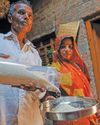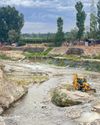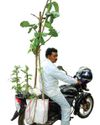
KANU BEN Patadia looks at her palms and remembers when they would be covered in soot all the time. “Only in the last six years have my hands been this clean,” she says. The soot she refers to came from operating oil-powered pumps all day long to make something none of us can live without— salt. It disappeared once she shifted to solar-powered pumps.
Kanu Ben belongs to the Agariya community that has been involved in making salt for centuries in the Little Rann of Kutch (LRK)—a 5,000 square kilometer salt marsh in the Rann of Kutch in north Gujarat. By switching over to a solar-powered pump in 2015 (she bought a second one in 2017), Kanu Ben has saved about 15 tonnes of carbon dioxide from being released into the atmosphere, as per an estimate by Ahmedabad-based non-profit Vikas Centre for Development (VCD). According to the non-profit, the Agaria community has installed around 3,000 pumps since 2017-18, which would have saved release of around 12,000 tonnes of carbon dioxide. Overall, some 70 per cent of the 7,000 Agariya families in LRK have at least one pump, say non-profits in the region, though there is no official data on this.
Diese Geschichte stammt aus der January 16, 2022-Ausgabe von Down To Earth.
Starten Sie Ihre 7-tägige kostenlose Testversion von Magzter GOLD, um auf Tausende kuratierte Premium-Storys sowie über 8.000 Zeitschriften und Zeitungen zuzugreifen.
Bereits Abonnent ? Anmelden
Diese Geschichte stammt aus der January 16, 2022-Ausgabe von Down To Earth.
Starten Sie Ihre 7-tägige kostenlose Testversion von Magzter GOLD, um auf Tausende kuratierte Premium-Storys sowie über 8.000 Zeitschriften und Zeitungen zuzugreifen.
Bereits Abonnent? Anmelden

In leading role again
MOVIES AND WEB SERIES ARE ONCE AGAIN BEING SET IN RUSTIC BACKGROUNDS, INDICATING A RECONNECT BETWEEN CINEMA AND THE COUNTRYSIDE

One Nation One Subscription comes at a huge cost
As top US universities scrap big deals with top scientific publishers, India’s ONOS scheme seems flawed and outdated

Return of Rambhog
Bid to revive and sell the aromatic indigenous paddy variety has led to substantial profits for farmers in Uttar Pradesh's Terai region

Scarred by mining
Natural springs of Kashmir drying up due to illegal riverbed mining

Human-to-human spread a mutation away
CANADA IN mid-November confirmed its first human case of avian influenza, with a teenager in the British Columbia being hospitalised after contracting the H5N1 virus that causes the disease. The patient developed a severe form of the disease, also called bird flu, and had respiratory issues. There was no known cause of transmission.

True rehabilitation
Residents of Madhya Pradesh's Kakdi village take relocation as an opportunity to undertake afforestation, develop sustainable practices

INESCAPABLE THREAT
Chemical pollution is the most underrated and underreported risk of the 21st century that threatens all species and regions

THAT NIGHT, 40 YEARS AGO
Bhopal gas disaster is a tragedy that people continue to face

A JOKE, INDEED
A CONFERENCE OF IRRESPONSIBLE PARTIES THAT CREATED AN OPTICAL ILLUSION TO THE REALITY OF A NEW CLIMATE

THINGS FALL APART
THE WORLD HAS MADE PROGRESS IN MITIGATING EMISSIONS AND ADAPTING TO CLIMATE IMPACTS. BUT THE PROGRESS REMAINS GROSSLY INADEQUATE